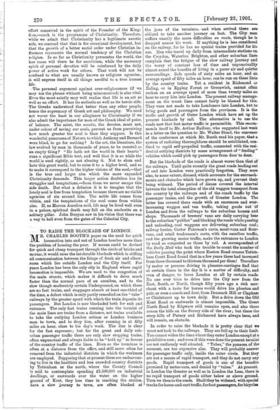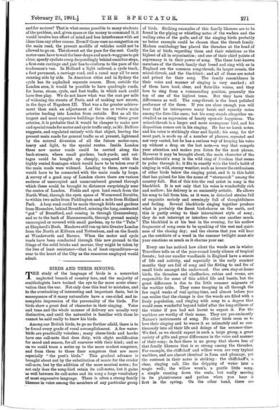TO RAISE THE BLOCKADE OF LONDON.
it TR. CHARLES BOOTH'S paper on the need for quick ../.-XL locomotion into and out of London touches more than the problem of housing the poor. If means could be devised for quick and cheap transport through the circle of bricks and mortar, it would raise the intolerable blockade which is stifling all communication between the fringe of fresh air and elbow_ room which lies outside London and the City itself. For years London has been the only city in England where rapid locomotion is impossible. We are used to the congestion of the main streets, which makes it difficult to drive much faster than the normal pace of an omnibus, and to the slow though moderately certain Underground, on which there are no fast trains, and stoppages absorb at least one-third of the time, a defect which is only partly remedied on the " tube " railways by the greater speed with which the train deposits its passengers. But London is now blockaded both for exit and entrance. The only fast trains running into the termini of the main lines are trains from a distance, not trains available to take the outlying London artisan or London business man to town, and to drop him, after running in at fifty miles an hour, close to his day's work. The line is clear for the fast expresses ; but for the great and daily sub- urban passenger traffic there are only slow stopping trains, often unpunctual and always liable to be "held up" in favour of the country traffic of the lines. Even so the terminus is often at a distance from the office, and still more often far removed from the industrial districts in which the workmen are employed. Supposing that at present these are endeavour- ing 'to live in the healthier and less crowded country districts by Tottenham Or the north, where the County Council is said to contemplate spending R1,500,000 on industrial dwellings, or eastwards over the water on the higher ground of Kent, they lose time in reaching the station, have a slow journey to town, are often blocked at the jaws of the terminus, and when arrived there are obliged to take another journey on foot. The City man suffers exactly the -same difficulties es route, though he is dropped nearer his work. If anything he is less considered on the railway, for he has no special trains provided for his use. Men who travel up daily from intermediate stations oh the Croydon, Waterloo, Brighton, and other suburban 'are complain that the fatigue of the slow railway journey and the worry of constant loss of time and unpuncttudity almost annul the benefits of living in a purer air and quieter surroundings. Safe speeds of sixty miles an hour, and an average speed of fifty miles an hour, can be run on these lines by the country trains. Yet _a. resident in Richmond- Ealing, or in Epping Forest or, Greenwich, eannot .often reckon on an average speed of more than twenty miles an hour to carry him into London. The present railway manage- ment on the trunk lines cannot fairly be blamed for this. They were not made to take Londoners into London, but to bring goods and passengers from the provinces. It is the traffic and growth of Outer London which have set up the present blockade by rail. The alternative is to. uae the roads now that fast motor traffic is permissible. This recom- mends itself to Mr. Arthur Balfour, who suggested last week in a letter on the question to Mr. Walter Stead, the convener of the conference at which Mr. Booth read his paper, that a system of radiating thoroughfares should be established,-con- fined to rapid self-propelled traffic, connected with the resi- dential outlying districts by some arrangement of " feeding " vehicles which could pick up passengers from door to door.
But the blockade of the roads is almost worse than that of the railways. Until quite recently the great roads leading-out of and into London were practically forgotten.. They.were also, to some extent, disused, which accounts for the encroach- ments and obstacles which have grown up, and prevent their being widened. The period of disuse covered the interval between the total absorption of the old. waggon transport_from the country by the railways and of the coach traffic by the passenger trains, and the growth of Greater London. The latter has covered these roads with an enormous and ever- increasing waggon and van traffic, taking goods hut of London and from the railways to the suburban houses and shops. Thousands of brewers' vans are daily carrying beer to the suburban "publics" and blocking the roads while passing and unloading, coal waggons are delivering suburban coal; railway lorries, Carter Paterson's carts, meat-vans and flour- vans, and retail tradesmen's carts, with the omnibus traffic, and the growing motor traffic, make the entrances to Londdn by road as congested as those by rail. A correspondent of the Daily Mail who took the trouble to count the nuniber of vehicles passing the point where Euston Road crosses Totten- ham Court Road found that in a few years these had ificivased from three thousand to thirteen thousand per diem! Travellers by motor or persons driving in pleasnre-carriages find that at certain times in the day it is a matter of difficulty, and even of danger, to leave London at all by certain roads. No one ever tries to drive into the City now from the East, South, or North, though fifty years ago a rich mer- chant with a taste for horses would drive his phaeton and pair, or even a coach and four, from Denmark Hill or Clapham or Chislehurst up to town daily. But a drive down the Old Kent Road or eastwards is almost impossible. The Great North Road by Edgware still remains open, and also those across the hills on the Surrey side of the river; but there the steep hills of Putney and Richmond have always been, and will remain, an obstacle.
In order to raise the blockade it is pretty, clear that we must not look to the railways. They are full up to their limit. You cannot widen the lines where they enter London except at a prohibitive cost; and even if this were done the present termini are not uniformly well situated. "Tubes," the panacea of the moment, are too expensive also. They will probably answer for passenger traffic only, inside the outer circle. But they are not a means of rapid transport, and they do not carry any goods. Rapid transport. of goods is one of the benefits promised by motor-cars, and denied by "tubes." 'At present, in London the Greater as well as in London the Lees, there is no rapid transport of goods either below or above ground. Turn we then to the roads. Shall they be widened, with special tracks for horse-and-cart traffic, for foot passengers, for bicycles 4nd for motors? That is what seems possible to many students of the problem, and, given space or the money to command' it, it would involve less effort of mind and less interference with set ideas than any other course. Evenif there were no congestion on the main road, the present muddle of vehicles could not be allowed to go on. The slowest set the pace for the rest. Costly motor-cars have to wait for beer-drays and muck-waggons to get clear, speedy cyclists creep despondingly behind omnibus steps, a first-rate carriage and pair has to conform to the pace of the tradesman's van. In Holland a light railroad, a cycle track, a foot pavement, a carriage road, and a canal may all be seen running side by side. In American cities and in Sydney the cycle has its asphalted separate course. Here, outside the London area, it would be possible to have quadruple roads, for horse, steam, cycle, and foot traffic, in which each could have free play. We do not know what was the cost per mile of widening the streets of Paris, and of making new streets, in the days of Napoleon III. That was a far greater achieve- ment than such an adjustment of the ten or twelve main arteries leading into London from outside. But as all the largest and most expensive buildings form along these great arteries, it is probable that it would be cheaper to make new and special roads for motor and cycle traffic only, as Mr. Balfour suggests, and regulated entirely with that object, leaving the present main roads for general traffic as at present, lightened by the natural diversion of all the future motor-cars, heavy and light, to the special routes. Inside London these new motor roads could be carried along the back-streets, -where small gardens, back-yards, and cot- tages could be bought up cheaply, compared with the highly rented frontages which would have to be taken over if the main roads were widened. Leading to these, new roads would have to be connected with the main roads by loops. A survey of a good map of London shows there are various enclaves of unoccupied and unencumbered ground through which these could be_ brought .to_dista,nces surprisingly near the centre of London. Fields and open land reach from the North-West, through the open, space of Wormwood Scrubbi3, to within two miles from Paddington and a mile from Holland Park. A loop road could be made through fields and gardens from Hounslow, behind Brentford, missing the long, contracted "gut" of Brentford, and coming in through Gunnersboxy, and so to the back of Hammersmith, through ground mainly unoccupied or covered with small gardens, up to the " Tube " at Shepherd's Bush. Meadows still run up into Greater London from the North at Kilburn and Tottenham, and on the, South at Wandsworth and Barnes. When the motor and cycle roads have been conducted through this new ground to the fringe of the solid bricks and mortar, they might be taken by the line of least resistance—that is, of least expenditure—as near to the heart of the City as the resources employed would admit.







































 Previous page
Previous page